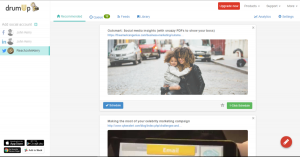Introduction
Your company’s marketing team has done a great job bringing in new leads to your CRM, and now it’s your turn to make some sense out of an overwhelmingly long list of new contacts. Depending on the landing page a given new prospect filled out, you could have various pieces of information for each contact such as their name, email, company name, or job title.
Your first thought? You feel like you’ve suddenly become a detective that has to piece together all the clues provided for each lead, and while that’s true, and you will need to do some detective work, don’t jump the gun! You’ve got a couple of steps to get through before you start digging around LinkedIn.
Step 1: Brainstorm your Ideal Buyer Profile
If you were to envision the McDreamy of companies to fall into your CRM lap, what does it look like? Does this company do B2B or B2C? Are they active on social media? Does the company belong to a specific industry? Looking for a business that’s more local, or are you in the market to expand your circles internationally? With your Ideal Buyer Profile in mind, you’ll be able to make a better judgment as to who you want to spend your time developing relationships with.
Step 2: Create a Prospect Fit Matrix
Before you even begin to look at your CRM, grab a piece of paper (or open up a new Doc on your computer) and make yourself a table with three columns. Congrats! You just took your first step in creating your very own Prospect Fit Matrix. This will be your ultimate cheat sheet to grade each contact on how closely they match your Ideal Buyer Profile and therefore how good of a fit they might be for your company to take on as a client. Each column will represent if a given new contact is ranked strong, moderate, or weak in various categories. The checklist will be comprised of areas you’ve created during your brainstorming phase as such industry, location, role, and engagement. Keep this handy as you begin to do your research about your prospects to give you an objective view of who you’re really looking at. Just like when looking for any match, you can get distracted by flashy or interesting companies, but if they’re not a good fit for what you’re truly looking for, they’re probably not worth your time.
Step 3: Get your Sherlock hat on
Now that you’ve prepped your Ideal Buyer Profile and got your Prospect Fit Matrix handy, you’re ready to dive in. To get started, choose a contact. What information do you have about them? If you have a company name or website, go check that out. A website, while not as concise as LinkedIn will give you an in-depth understanding of the company and how they present themselves. It will give you a feel for the audience they’re looking to attract, their organizational culture, their products or services, and possibly even their pricing. If you’re looking for a company with a strong social media presence, those links are usually provided at the bottom of each page or on their Contact Us page. This will help you begin checking off items on your Prospect Fit Matrix. Still have some more categories to check? Head on over to LinkedIn.

On Linkedin, you’ll be able to get an overview of the company in a snap. See their location, industry, and number of employees on one page. If you’re having a difficult time getting an idea of their annual revenue, seeing the size of the company can help you ballpark how much they’re bringing in based on how many employees the company can support.
Notice how up until now, we’ve mostly been talking about the company in question, not the personal contact himself. Sometimes the contact is the decision-maker you’re looking to get in touch with, and sometimes the contact’s someone in a more basic or mid-level position. Don’t worry! There’s a good chance that contact was sent out to do research and they found your site. If they’re otherwise a great fit, reach out to them and ask if there’s someone else in their company they suggest you get in touch with.
Step 4: Now vs. Nurture
As you go down your list filling in the blanks of each contact’s info, start moving them into one of two lists: Connect or Nurture. Your Connect list will include all your strong leads that scored high on just about every category on your Matrix. These eligible partners you can later reach out to via phone or email. Your Nurture list includes contacts that didn’t score as well, but that doesn’t mean they’re duds! Subscribe them to your monthly newsletter to keep them in the loop about how you’re growing and continually feed them valuable content. That way, if and when the time comes that they’re more in your league (e.g. the company’s annual profits grow, the contact gets promoted to a decision-maker position), you’ll be the first company they think of to contact. Another great way to ensure they remember you is to follow them. Be in on LinkedIn, Twitter, Facebook, or Instagram, you can give their content some love with likes and positive feedback. They might just follow you back making it the beginning of a beautiful friendship.
Business & Finance Articles on Business 2 Community
(48)








